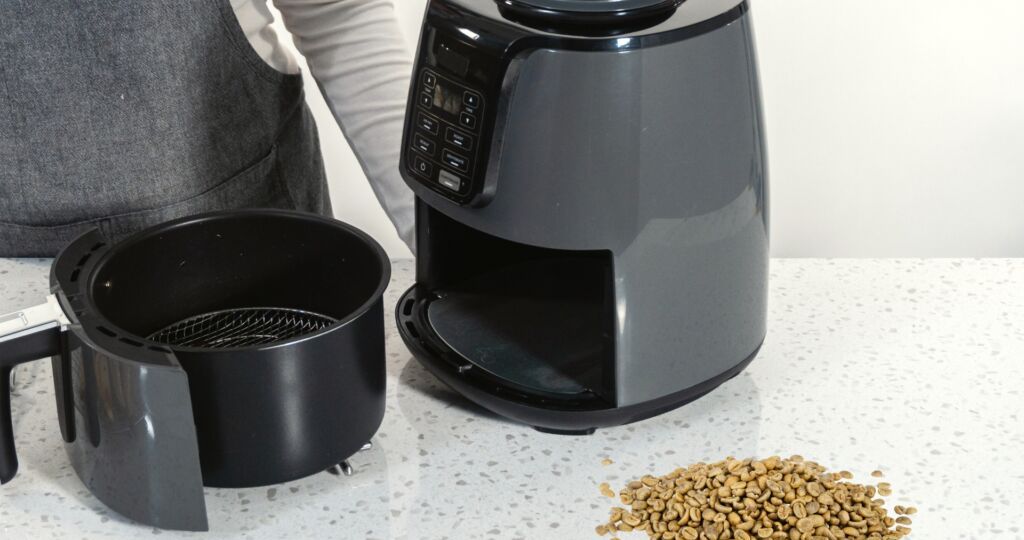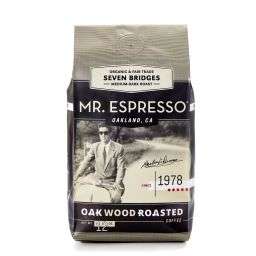
Coffee roasting is a crucial process that transforms the chemical and physical properties of green coffee beans into roasted coffee products. The roasting process is what gives the coffee beans their distinct flavor, aroma, and color.
Traditionally, coffee roasting has been performed using specialized equipment designed to heat the beans uniformly, allowing for a range of roast levels—from light to dark—each offering a unique flavor profile. Methods such as drum roasting, air roasting, and pan roasting have been widely used, each method impacting the beans’ flavor in distinct ways.
Why Use an Air Fryer?
The use of an air fryer for roasting coffee beans presents a novel and convenient approach, diverging from traditional roasting methods. Air fryers offer several advantages that make them an attractive option for coffee enthusiasts looking to roast beans at home.
Firstly, air fryers are highly accessible and easy to use, requiring minimal setup and no specialized roasting equipment. This accessibility opens up the world of coffee roasting to a broader audience, allowing more individuals to experiment with roasting their own beans.
Furthermore, air fryers are time-saving and cost-effective. They can roast coffee beans in a fraction of the time it would take using traditional methods, without the need for constant monitoring. This efficiency is not only a matter of convenience but also contributes to energy savings.
Additionally, the compact size of air fryers makes them suitable for use in home kitchens, where space may be limited. The ability to roast coffee beans in an air fryer democratizes the roasting process, providing coffee lovers with the tools to customize their coffee experience from the comfort of their own homes.
Types of Coffee Beans
The world of coffee is dominated by two primary species of beans: Arabica and Robusta. Arabica beans are celebrated for their smooth, complex flavor profiles, often featuring hints of fruit and sugar, with a higher acidity and a lower caffeine content compared to Robusta. Robusta beans, on the other hand, are known for their strong, robust flavor, with a grainy or woody character and a higher caffeine content.
This makes them less sweet but ideal for those seeking a vigorous coffee experience. When selecting beans for roasting, it’s crucial to consider these characteristics to ensure the final product aligns with your flavor preferences. Arabica beans are generally preferred for their quality and flavor complexity, making them a popular choice for home roasting.
Understanding Roast Levels
Roast levels significantly impact the flavor and aroma of the coffee, ranging from light to dark roasts. Light roasts feature a light brown color, offering a mild flavor and pronounced acidity, preserving the bean’s original characteristics. They are typically roasted to a temperature just before the first crack. Medium roasts, with a medium brown color, offer a balanced flavor, aroma, and acidity, often with fruity or nutty notes, and are roasted until just after the first crack.
Medium-dark roasts present a richer, darker color with some oil on the surface, offering a bittersweet aftertaste, and are taken to the beginning of the second crack. Dark roasts produce shiny black beans with an oily surface and a pronounced bitterness, roasting well into the second crack, where the original flavors of the bean become overshadowed by the flavors of the roasting process.
Preparing to Roast
Equipment and Setup
Choosing the right air fryer for coffee roasting is paramount. Opt for a model with adjustable temperature control and a timer for precise roasting. The air fryer should offer enough space for the beans to move freely, ensuring even roasting.
Necessary accessories include a container for cooling the beans post-roast and a metal colander or sieve for removing chaff. Adhering to safety tips, such as placing the air fryer in a well-ventilated area and wearing protective gloves, can prevent accidents.
Pre-Roast Bean Preparation
Before roasting, cleaning and drying the coffee beans are essential steps to remove any debris or moisture that could affect the roasting quality. Equally important is ensuring the beans are of a uniform size; this uniformity leads to even roasting, preventing under or over-roasted beans within the same batch. These preparatory steps are foundational to achieving the desired roast level and flavor profile.
Roasting Process Overview
Roasting coffee beans in an air fryer involves a precise sequence of steps to transform raw, green beans into aromatic, flavorful coffee. The process is straightforward but requires attention to detail to achieve the desired roast level and flavor profile.
This guide will navigate through the essential stages of roasting, from preheating the air fryer to the post-roasting cooling and storage.
Preheating and First Steps
Begin by setting the air fryer to the appropriate temperature for the desired roast level. Preheat the air fryer to around 200°C (392°F), ensuring it reaches the temperature before adding the beans. This step is crucial for achieving an even roast from the onset.
Roasting Stages: From First Crack to Second Crack
As the beans roast, they’ll go through two significant phases known as “cracks,” which are audible cues indicating the stages of roasting. The first crack occurs when beans expand and crack open, signaling a light to medium roast. This stage usually happens between 3 to 5 minutes into roasting.
If a darker roast is desired, continue heating until the second crack, which is a louder, more intense cracking sound indicating a medium-dark to dark roast. Monitoring the beans closely and adjusting the air fryer’s temperature and roasting time is essential to achieve the desired roast level.
Stirring and Monitoring
Stirring the beans periodically throughout the roasting process is crucial for ensuring an even roast. Use a wooden spoon or shake the basket gently to redistribute the beans. Keep an eye on the color change and pay attention to the smell. The beans will transition from grassy to a rich, coffee aroma as they roast.
Cooling the Roasted Coffee Beans
Immediately after roasting, cooling the beans quickly stops the roasting process. Spread the beans in a single layer on a baking sheet or a metal colander to cool them rapidly. Removing the chaff, the flaky outer skin of the beans, is also important during this stage to ensure a clean final product.
Storage and Degassing
Once cooled, store the roasted coffee beans in an airtight container out of direct sunlight to maintain freshness. It’s essential to allow the beans to degas for about 12 to 24 hours before brewing. Degassing is the process of releasing carbon dioxide that builds up during roasting, which is crucial for developing the coffee’s optimal flavor profile.
Adjusting for Bean Varieties and Preferences
Each variety of coffee bean comes with its unique characteristics, requiring adjustments in roasting times and temperatures. Experimentation is key to finding the sweet spot for each type. Arabica beans, for example, might benefit from a slightly lower temperature to preserve their delicate flavors, while Robusta could handle higher temperatures to enhance its robust profile.
Keeping notes on different bean varieties and how they react to roasting conditions can help refine the process to suit personal taste preferences.
Troubleshooting Common Issues
Uneven roasts often result from insufficient stirring or overcrowding in the air fryer basket. Ensure beans are not piled up and are stirred frequently for even exposure to heat.
If the flavor doesn’t meet expectations, consider adjusting the roast level; lighter roasts retain more of the bean’s inherent flavors, while darker roasts offer a more toasted, bitter profile. Experimenting with small adjustments can lead to significant improvements in flavor.
Benefits and Drawbacks of Using an Air Fryer
The air fryer offers a unique set of advantages for coffee roasting, including time efficiency, precise temperature control, and even heat distribution, which are essential for achieving consistent roasts. Additionally, the enclosed space helps retain the beans’ natural flavors, resulting in a rich and aromatic final product.
Drawbacks
Despite its advantages, using an air fryer for coffee roasting comes with limitations, such as its capacity, which might not cater to larger batches. Achieving uniformity in roast can also be challenging due to the air fryer’s design, requiring more attention to stirring and monitoring during the process.
Conclusion
Roasting coffee beans in an air fryer presents a novel approach to achieving delicious, home-roasted coffee. This method combines convenience with control, allowing enthusiasts to experiment with various beans and roast levels.
While there are some challenges, such as capacity limitations and the need for frequent stirring, the benefits of quick, flavorful roasting at home are undeniable. Embracing the air fryer for coffee roasting can add a rewarding and personalized touch to the coffee brewing experience, offering a fresh perspective on this beloved ritual.









